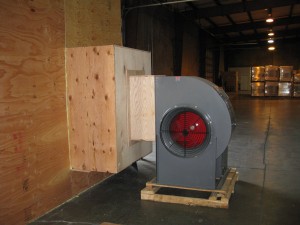Interior plenum, toggle clamps, and pitot tubes installed
 Airflow straightener installed
Airflow straightener installed
Check back soon for a detailed look at the testing process and some discussion of the major the components that went into building our new test lab
If you’re in the Bay Area and want to see an AirScape 1.7 WHF and Solar Attic Fan in person, check out Your Energy Solutions energy outlet store in Pleasanton, CA
We gutted an old shipping office to use as the structure of our new test lab. The biggest challenge was making it as airtight as possible (the testing standard does allow for a minimal amount of leakage).
A S&P CM Series Belt Driven Blower about to be installed.This giant fan provides incoming air and is capable of 500 to 8,000 CFM. We are also able to install a smaller less powerful fan to provide incoming air for fans that move less than 500 CFM.
Check back soon for more photos
A little while ago we began to revamp and rebuild our fan test lab to make it bigger, better, and easier to use. We thought it would be fun to share some of the pictures of the construction of this new test facility.
A little background: We test all of our units to ensure that when we say it is 1710 CFM and 157 watts, that it is actually 1710 CFM and 157 watts. All of our Whole House Fans (WHF) are tested as you would install them in your home. Often the other guys will just test the fan itself and “forget” to test their WHF as a system (damper box, fan, duct, and grille). This kind of testing leads to misleading results, specifically greater CFM and lower watts than when installed as a system.
The old: This facility used a traverse method of testing airflow. We used a calibrated and certified hot wire anemometer to test air velocity. Soon after this picture was taken we straightened the silver tube, as we found the two bends were causing pressure waves affecting the testing.
Testing: A 1.7 WHF about to be tested as installed in the attic. We used a multimeter and a power meter, both calibrated and certified, to measure volts and watts.
The new: The new and improved test lab under construction at our warehouse in Medford, OR. Check back soon for more pictures of the construction process.